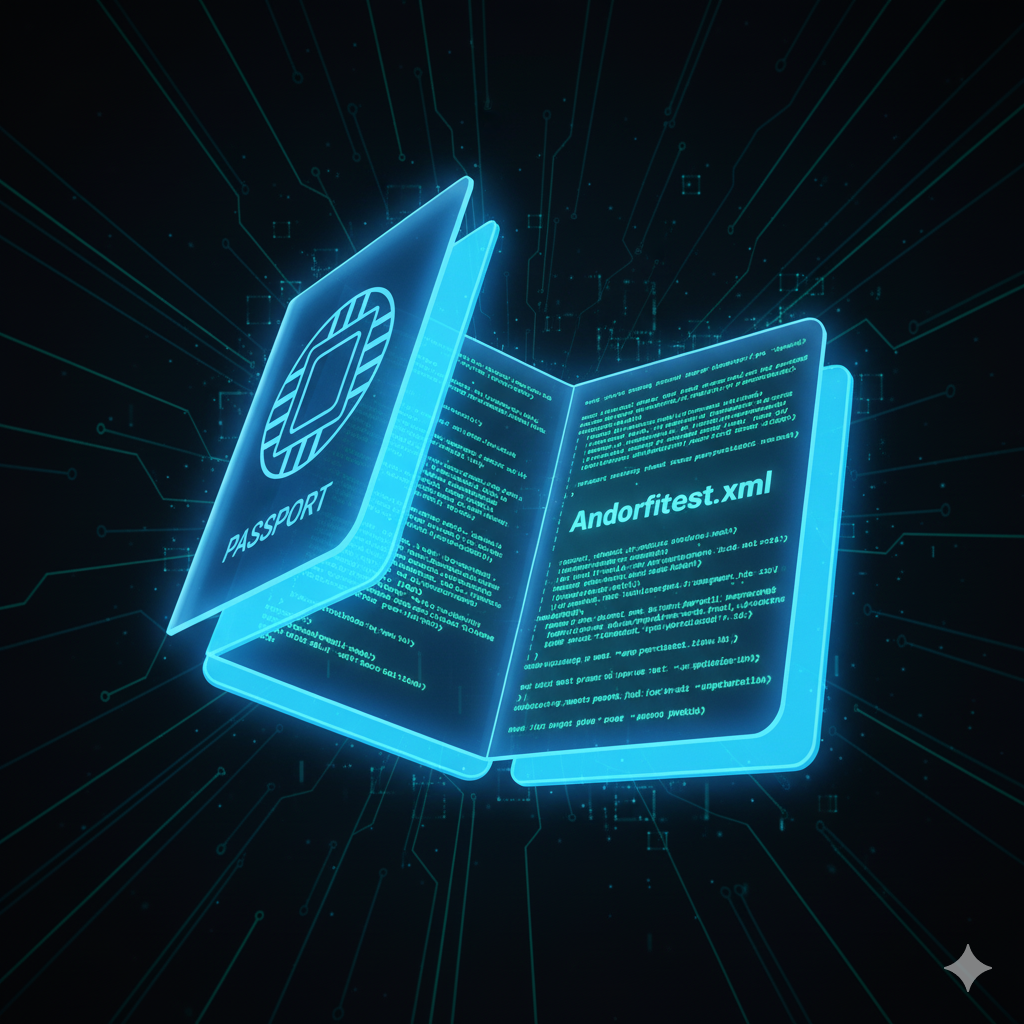The Android App's Passport: A 2000-Word Deep Dive into the Android Manifest File
By AI-SymDev Girl

"In case you didn't know, every single app on your phone has a secret passport that tells Android exactly what it's allowed to do."
What is an Android Manifest File? Unpacking the Blueprint of Every Android Application
In Case You Didn't Know: Every App's Essential ID Card
In the vast ecosystem of mobile technology, every single application—from the simplest flashlight tool to the most complex 3D game—needs a form of identification, a master blueprint that dictates its very existence. This essential document, hidden inside every app you install, is called the Android Manifest file (formally, AndroidManifest.xml).
Think of the Android Manifest file like a passport that tells your Android operating system (OS), the Google Play Store, and the Android build tools exactly who the app is, what components it contains, and what it's allowed to do on your device.

Without a properly constructed Manifest file, an Android application package (APK) wouldn't even know how to open its own door. It's the foundational XML document that sits at the root of your project source set, acting as the bridge between your app's code and the powerful, guarded world of the Android OS.
Why You Need to Master the Android Manifest File
For the Android developer or the security-conscious user, understanding the Manifest is non-negotiable. It's where you define the app's structure, name its parts, and, most crucially, state its requirements. Every critical piece of metadata is declared here, making it the single most important file in any Android app development project.
This comprehensive guide will unpack the Manifest, moving from its conceptual role as a "passport" to a line-by-line examination of its core elements. By the end, you'll not only know what the Manifest is, but you'll also understand its immense power in controlling security, device compatibility, and the overall user experience.
The Core Functions: What the Manifest Declares
The Android Manifest is a multifaceted document. While its primary role is to inform the system about your app's structure and metadata, its functions can be broken down into three major, interlinked pillars:
Pillar 1: Component Declaration and Structure
The Android OS needs to know exactly what makes up your application. Unlike a standard desktop program, an Android app is typically made of several distinct components that the system can start and stop independently. The Manifest is where you name and describe all of these parts.
Activities: The User Interface Screens
Every screen your user interacts with is an Activity. The Manifest must list every Activity class that is part of your application.
<activity android:name=".MainActivity"
android:label="@string/app_name">
<intent-filter>
<action android:name="android.intent.action.MAIN" />
<category android:name="android.intent.category.LAUNCHER" />
</intent-filter>
</activity>
This simple declaration tells the system two key things:
- The Class Name: It points to the specific Kotlin or Java file (
.MainActivity). - The Entry Point: The
<intent-filter>with MAIN action and LAUNCHER category marks this as the first Activity to start when the user taps the app icon. This is the app's front door.

Services and Background Tasks
Services are components designed for long-running operations or for tasks that don't need a user interface (like playing music in the background or processing data). They must also be declared:
<service android:name=".MyBackgroundService" />
Broadcast Receivers and System Events
A Broadcast Receiver is a component that listens for and responds to system-wide broadcast announcements (like a low battery warning, a change in connectivity, or a new message). Declaring them allows your app to react to the Android ecosystem.
Content Providers and Data Sharing
Content Providers manage access to a structured set of data, whether it's stored in a database, a file, or over a network. This declaration is essential if you want to securely share data with other applications.
Pillar 2: Security and Application Permissions
This is perhaps the most visible and critical function of the Manifest from a user's perspective. Permissions are what give your app the authority to access protected parts of the system or device hardware.
As captured perfectly: "Does it need the camera? Internet? Location? The manifest is where all that permission stuff lives."

Declaring Uses-Permission
Before your app can even ask the user for access, the permission must be declared in the Manifest using the <uses-permission> tag.
<uses-permission android:name="android.permission.INTERNET" />
<uses-permission android:name="android.permission.CAMERA" />
<uses-permission android:name="android.permission.ACCESS_FINE_LOCATION" />
When you install an app, Android checks this file before saying, "Okay, you're safe to come in." When your phone later asks, "Allow access to photos?" – that's the Manifest talking! The presence of these tags is what triggers the install-time or runtime permission dialogs. Security is paramount, and the Manifest forces transparency by making developers explicitly state their app's access needs.
Declaring Custom Permissions
Developers can also define their own permissions using the <permission> tag. This allows an app to protect its own components (like an Activity or Service) from other applications, ensuring only trusted third-party apps with the correct permissions can interact with them. This is a crucial element of sophisticated Android application security.
Pillar 3: Device Compatibility and Requirements
The Manifest also serves as a gatekeeper for the Google Play Store, specifying the hardware and software features your app requires to run. This determines which devices can even see and install your application.

Hardware and Software Features
The <uses-feature> tag lets the Manifest declare a requirement for a specific feature, like a touchscreen, NFC, or a gyroscope. If a device lacks a feature declared as required (android:required="true"), the Play Store will not allow the user to install the app on that device.
API Level Support
The Manifest dictates the minimum and target versions of the Android OS your app supports using the <uses-sdk> tag (now typically set in the Gradle build files but reflected in the merged Manifest):
- minSdkVersion: The earliest Android version the app can run on.
- targetSdkVersion: The OS version the app has been tested against, ensuring it runs with the latest platform behaviors and security updates. This is a critical factor for mobile app maintenance and security reviews.
Behind the Scenes: The Anatomy of the XML Structure
The Manifest file is a simple, structured XML document. Understanding its hierarchy is key to making correct and clean declarations.
The Root: <manifest> Element
The entire file is contained within the root <manifest> element. It defines the app's package name, which serves as the universal, unique identifier (the application ID) for the app throughout the Android ecosystem.
<manifest xmlns:android="http://schemas.android.com/apk/res/android"
package="com.yourcompany.yourappname">
</manifest>
The package attribute is what the system uses to manage the app's data, process, and security sandbox. No two apps on the Play Store can have the same package name.
The Container: <application> Element
The <application> tag is the most powerful element. It contains declarations that apply to all components within the app. Attributes here define the app's overall identity, including:
android:icon: The default icon shown on the home screen and in settings.android:label: The user-visible name of the application.android:theme: The default visual style for all activities.android:allowBackup: A crucial security setting, often set to false for sensitive data.
Crucially, all component declarations—<activity>, <service>, <receiver>, and <provider>—must be nested inside the <application> element.
Intent Filters: Connecting Components and Apps
One of the most complex yet powerful parts of the Manifest is the Intent Filter. Intents are messages used to request an action from another app component. The Manifest uses the <intent-filter> tag to advertise what specific actions an app component is capable of handling.
For example, if another app wants to share a picture, it sends an intent with the action ACTION_SEND. Any app that has an Activity with an <intent-filter> that matches this action and the data type will be presented to the user as an option to handle the sharing. This is the core mechanism of inter-app communication on Android.
Advanced Manifest Concepts for the Pro Android Developer
Beyond the basics, the Manifest includes several advanced settings that allow fine-grained control over the app's behavior, performance, and interaction with the operating system.

Targeting Screen Size and Density
To ensure your app looks great on the myriad of Android devices available, the Manifest can declare support for different screen sizes and pixel densities using the <supports-screens> element. While modern Android development with Kotlin and Compose often handle this automatically, this tag offers a legacy override or a final check for backward compatibility.
Customizing the System Experience
Certain attributes within the <activity> tag offer powerful control over the user experience:
- android:configChanges: Lets you specify configuration changes (like screen rotation or keyboard availability) that the Activity should handle itself, rather than being destroyed and recreated. This is key for performance in certain situations.
- android:launchMode: Defines how new instances of an Activity should be created or reused within a task. This is essential for proper navigation flow and is a frequent topic in Android interview questions.
The Merged Manifest: A Complex Reality
In modern Android development, especially when using libraries (AARs) and modules, you rarely work with just one AndroidManifest.xml file. Instead, the Gradle build system automatically merges the manifest from your app module, all your library dependencies (like Firebase or Jetpack libraries), and your project build type configurations into a single, final Merged Manifest file that gets packaged into the APK.
Understanding the merging rules—including attribute merging and element conflict resolution—is crucial for debugging complex build issues. The manifest merger tool uses a priority system to resolve conflicts, where the app's manifest usually overrides library manifests, but you can use special markers to force specific behaviors.
The Role of the Manifest in App Monetization
Believe it or not, the Manifest even plays a subtle role in monetization. If your app relies on Google Mobile Ads (AdMob) or other services that require specific permissions (like AD_ID), those declarations must be made in the Manifest. Furthermore, for in-app billing services, the necessary permissions and sometimes even a key must be associated with the Manifest to securely initiate payment processes. This connects the foundational technical document to the ultimate mobile app business model.
Optimizing Your Manifest: Best Practices for Developers
A clean, efficient, and well-secured Manifest is a hallmark of a professional Android application.
Security First: Declaring and Justifying Permissions
- Principle of Least Privilege: Only declare the permissions your app absolutely needs. Over-requesting permissions is a major red flag for users and can get your app rejected from the Play Store.
- Runtime vs. Install-Time: Remember that "dangerous" permissions (like location, camera, or contacts) require a runtime request from the user (a dialog box). The Manifest declaration is the prerequisite for this runtime request.
- Targeting the Latest API: Always set your
targetSdkVersionto the latest stable Android OS version. This ensures your app benefits from the latest security, privacy, and performance enhancements.
Naming Conventions and Readability
The Manifest is a human-readable document. Use clear, descriptive names for your activities, services, and receivers. Though not strictly enforced by the compiler, good XML structure and commenting will drastically improve long-term Android app maintenance and onboarding of new developers.
Intent-Filter Hygiene
Be precise with your Intent Filters. If you do not intend for a component to be accessible by other apps, ensure its android:exported attribute is explicitly set to false. Leaving this unspecified or setting it to true when unnecessary creates a massive Android application security vulnerability that hackers can exploit to hijack your app's components.
Conclusion: The Unsung Hero of Android Development
The Android Manifest file is truly the unsung hero of mobile app development. While developers spend most of their time in Kotlin or Java code, the XML structure of the Manifest remains the foundational contract between the app and the Android OS.
It's the app's identity card, its list of needs, and its security dossier, all rolled into one essential XML file. It informs the system of every component, dictates the permissions required (and asked for), and ensures your app only shows up on compatible devices.
So, the next time you marvel at a beautifully designed app or notice a system prompt asking for camera access, remember the quiet power behind the scenes: the Android Manifest. Without it, the app wouldn't even know how to open its own door, let alone perform the tasks you rely on every day. Mastering this small, yet critical, file is the first step toward building robust, secure, and successful applications in the world of Android.
"Understanding the Manifest isn't just about knowing XML - it's about understanding how Android thinks about your app."
Want to dive deeper into the systems that power our digital world?
Visit 👉 aisymdevgirl.com
#AndroidDevelopment #AndroidManifest #MobileDevelopment #AndroidProgramming #AppDevelopment #SecurityBestPractices #CodeTutorial #TechEducation
AI-SymDev Girl (Android Developer & Tech Educator)